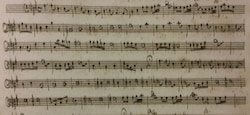This is another follow-up on my essays The Leaping Romanesca (The Pachelbel Pattern): The Basics, The Leaping Romanesca: Two Part Embellishment (Part 1), The Leaping Romanesca: Two-Part Embellishment (Part 2)) and The Leaping Romanesca: Embellishing Three-Part Settings. In this essay, I show how to use stretto in the context of the Leaping Romanesca. Again, my elaborations are grounded in German and Italian 18th-century repertoire and pedagogical sources.
Stretto —imitation in canonic fashion— is a contrapuntal technique applicable to the Leaping Romanesca. To this end, 1 or 2 upper voices imitate the bass line of the Leaping Romanesca. Depending on the setting, imitation can occur at the octave or at the tenth.
In this essay, I will illustrate stretto first in the context of two-part settings of the Leaping Romanesca, then in the context of three-part settings.
Two-Part Stretto at the Octave
A straightforward two-part stretto with the Leaping Romanesca bass is as follows. The bass enters alone during the first two stages. The upper voice imitates the Leaping Romanesca bass an octave higher, starting at the bass’s third stage. We speak here of stretto at the octave. Because each subsequent segment of the Leaping Romanesca (bass) is a third lower than the previous one, this setting produces parallel thirds between both voices:

Two-Part Stretto Sine Pausa
The version above can be easily transformed into a version in which the upper voice simply accompanies the bass in parallel thirds (actually tenths) throughout. To this end, the whole rest in bar 1 becomes two half notes C♯-G♯:

Contrapuntists might call this setting a stretto sine pausa (without pause) at the tenth.
Two-Part Stretto Per Arsin Et Thesin
When one relocates the upper voice one quarter note to the right, another musically interesting realization of the Leaping Romanesca emerges, one with syncopations throughout:

One might speak here of a stretto per arsin et thesin at the tenth, although the term per arsin et thesin properly refers “to the entrance of a theme (usually a fugue subject) with displaced accents, former strong beats becoming weak and vice versa” (Walker, Arsis, thesis).
This version holds some interesting features:
- Thanks to the compound line during the even stages, a new harmonization of the Leaping Romanesca emerges, in which the even stages sound as sixth chords
- The uneven stages, apart from the first, are set with a 2–3 suspension in the upper voice. (As a result, the first-choice sonority on the downbeat of bar 4 would be B minor (not shown).)
Three-Part Stretto at the Octave
We can expand the two-part stretto at the octave into (a suggestion of) a three-part stretto at the octave:

The example above starts as the two-part stretto at the octave we saw above: the bass enters alone, the second voice —here the middle voice— imitates the bass an octave higher one bar later. The third voice —the upper voice— enters in bar 3 on ➊ as well. However, the second note (in orange) of this voice needs to be modified to avoid parallel fifths with the bass. (The fact that this modification results in a doubled third was not considered a problem.) The example below shows the erroneous voice leading when the third voice literally imitates the first two notes of the Leaping Romanesca bass (in red).

In Fenaroli’s circle, we also find a three-part stretto at the octave that is almost identical to the one above (with the orange note):

Instead of maintaining the stretto until the end of the third bar in the middle voice, also that voice breaks off the literal imitation in the second half of bar 3. As a result, the triad at that point is complete, including both third and fifth.
Three-Part Stretto Sine Pausa
The two-part stretto sine pausa can easily be transformed into a three-part version. In this case, the third voice does not participate at the stretto but merely produces the fifth on the uneven stages that becomes the octave on the even stages.

This voice leading too appears literally in Fenaroli’s counterpoint material.
Further Reading (Selection)
Primary Sources
Fenaroli, Fedele. METODO PER BENE ACCOMPAGNARE LIBRO 1, Partimenti, Critical edition, ed. Ewald Demeyere (Ottignies, 2021).
Fenaroli, Fedele. METODO PER BENE ACCOMPAGNARE LIBRO 1, Critical Comments, Critical edition, ed. Ewald Demeyere (Ottignies, 2021).
Fenaroli, Fedele. METODO PER BENE ACCOMPAGNARE LIBRO 2, Partimenti, Critical edition, ed. Ewald Demeyere (Ottignies, 2021).
Fenaroli, Fedele. METODO PER BENE ACCOMPAGNARE LIBRO 2, Critical Comments, Critical edition, ed. Ewald Demeyere (Ottignies, 2021).
Fenaroli, Fedele. METODO PER BENE ACCOMPAGNARE LIBRO 3, Partimenti, Critical edition, ed. Ewald Demeyere (Ottignies, 2021).
Fenaroli, Fedele. METODO PER BENE ACCOMPAGNARE LIBRO 3, Critical Comments, Critical edition, ed. Ewald Demeyere (Ottignies, 2021).
Fenaroli, Fedele. REGOLE MUSICALI PER I PRINCIPIANTI DI CEMBALO, A Comparative Edition (V1.0), compiled and edited by Ewald Demeyere (Ottignies, 2021).
Fenaroli, Fedele. The Parma Manuscript — Partimento Realizations of Fedele Fenaroli (1809), ed. Ewald Demeyere (Visby: Wessmans Musikförlag,2021).
Mattei, Stanisloa. Pratica d’Accompagnamento Sopra Bassi Numerati E Contrappunti A Più Voci (Bologna, 1824).
Paisiello, Giovanni. Regole Per bene accompagnare il Partimento (St. Petersburg, 1782).
Secondary Sources
Gjerdingen, Robert O. Music in the Galant Style (New York: Oxford University Press, 2007).
Gjerdingen, Robert O. Child Composers in the Old Conservatories — How Orphans Became Elite Musicians (New York: Oxford University Press, 2020).
IJzerman, Job. Harmony, Counterpoint, Partimento: A New Method Inspired by Old Masters (New York: Oxford University Press, 2018).
Paraschivescu, Nicoleta. Die Partimenti Giovanni Paisiellos — Wege zu einem praxisbezogenen Verständnis (Basel: Schwabe Verlag, 2018).
Paraschivescu, Nicoleta (Translator: Chris Walton). The Partimenti of Giovanni Paisiellos — Pedagogy and Practice (New York: University of Rochester Press, 2022).
Sanguinetti, Giorgio. The Art of Partimento — History, Theory, and Practice (New York: Oxford University Press, 2012).
